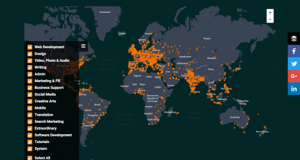Top 9 Technology Trends In The Next 5 Years

Technology is always changing and we can expect all sorts of new initiatives to take place in the next five years that will change how we live. Below are some of the most interesting technology trends we see coming in the next several years.
Expansion Of The Metaverse
We have been reading a great deal about the software development of the Metaverse and what the new Facebook initiative could look like in a few years. While it isn’t yet possible to live in the Metaverse, we think in five years, it will possible to fully immerse yourself there.
Right now, the Metaverse is where the World Wide Web was in the mid-90s. Many people believe once it advances and improves, the Metaverse will have a revolutionary impact on us like the Internet did. It’s expected this will forever change how we socialize, work, and live, and organizations that don’t adapt to the Metaverse will be wiped out.
The big driver of the Metaverse experience is gaming. As the Metaverse’s technical capabilities grow, more games will be available there that completely immerse you in the experience. And that life-changing experience is what will make people move to the Metaverse.
We could eventually get to the point where people live most of their lives in the Metaverse.
Edge Computing
One of the major concerns for many organizations today is the lag that can affect how operations are managed. That is why many industries are concentrating on how efficient and responsive computers are so data can be analyzed as quickly as possible. This is where edge computing comes into the picture.
Edge computing brings computer processes and data storage closer to organizations and reduces response times and lowers the amount of bandwidth used.
Some advantages of edge computing that we will see in the future are:
- Boosts cybersecurity to a new level by reducing problems with privacy regulations, local compliance, and the sovereignty of data. While many think that edge computing makes the possibility of cyberattacks more likely, the truth is that it reduces the impact on the organization if an attack occurs.
- Computer speed will increase dramatically with edge computing as it reduces latency. For instance, self-driving cars need faster computer processes because every fraction of a second the vehicle is moving is critical. Data analysis is limited to the edge, so processing speeds can be massively accelerated.
- Reduces the cost of keeping the data by categorizing it according to a management point of view. Data can be kept on locations on the edge so it reduces the cost of bandwidth.
Drones
Many people think drones will be much more common by 2024 and 2025. Right now, drones are mainly used only by videographers and photographers. But soon, drones will be cheap enough that a lot of people will want to own them. And with improved technology, they will be able to be flown for many hours at a time without a recharge.
Drones also will not require permission from the government in the next few years, so they could be used for more things. For instance, drones may be used more to find people or animals that are lost. There also could be more use of drones to deliver consumer goods.
There will be a time soon when none of us can go through a day without seeing a drone.
Blockchain
Many of us only think about blockchain technology in terms of cryptocurrencies such as Ethereum and Bitcoin. However, blockchain offers many types of security that are beneficial in other areas.
Blockchain is data that only can be added to and cannot be taken from or changed. Because the data cannot be changed, it makes it extremely secure. Also, blockchain is driven by consensus so no one person or organization controls the data. Blockchain means there isn’t a third-party gatekeeper keeping control of the transactions.
AI
Artificial intelligence will grow by leaps and bounds in the next few years. Recently, the idea of AI has advanced as researchers and scientists have found more innovative ways to use the tech.
We think one area that will expand rapidly for AI is healthcare. With the development of artificial neural networks and advanced deep learning, medical professionals will be able to do intellectual tasks a lot faster.
Further, AI in the medical field will help doctors to leverage data to notice patterns that can make the delivery of healthcare a more personal experience. Healthcare could see major changes because of AI with healthcare professionals spending more of their time working with the patient rather than understanding the diagnosis.
Cloud Computing
Cloud computing will only get bigger in the coming years as more organizations large and small put their data in the cloud and stop relying on local servers. We can expect a large transition to cloud computing in the next five years in many organizations, businesses, and industries.
There also will be more advances in alternatives to cloud computing, including edge computing (which we detail on this list) and fog computing. Fog computing bypasses the challenges with cloud computing not being able to process massive amounts of data in a short time.
Fog computing moves every function the network’s edge so speeds are much faster.
Robotic Process Automation (RPA)
RPA, like machine learning and AI, is another emerging technology that will automate many jobs. RPA involves the use of software to automate routine business processes including processing technologies, interpreting applications, manipulating data, and even answering texts and emails. RPA will essentially automate common tasks that people once did by hand.
Some sources estimate that robotic process automation will threaten the jobs of more than 200 million people and up to 9% of the workforce around the globe. RPA, however, also will create new jobs, and it is believed that most jobs can only be partially automated, not entirely replaced.
Tech professionals who want to learn the ins and outs of RPA will find jobs as RPA developers, analysts, and architects.
5G
No list of emerging tech trends is ever complete without talking about 5G. This is the new generation standard in mobile comms that offers faster speeds and reduced latency. This is great news because so many of us use our phones all the time to live our busy lives.
Of course, 5G networks have been developed for many years. But now the networks are starting to go online and 5G is offering much faster speeds on mobile devices and Internet connections are more reliable.
With so much more wireless bandwidth available, it’s not possible for more IoT devices to connect with each other. There also will be more possibilities in the future for self-driving vehicles and even smart cities. All of these things will be made possible by much faster wireless data transfers with 5G networks.
Quantum Computing
Quantum computing is a type of computing that uses quantum principles including quantum entanglement and superposition. This intriguing trend in technology is also part of preventing the spread of viruses and developing new vaccines. These things are possible with quantum computing because of the ease of monitoring, querying, and acting on data, no matter the source.
Quantum computing also should be of use in the future in finance and banking to reduce credit risk and detect fraud.
Quantum computers are now much faster than conventional computers and large brands of computers are now making significant advances in quantum computing.
This list of technology trends in the next several years shows how much technology changes in a short time. While all of these technologies are still relatively early in their lifecycles, we can expect that they will continue to improve and evolve in the next five years.
By the time another five years passes, it’s hard to imagine how much more advanced technology will be but we are sure it will be impressive!
The post Top 9 Technology Trends In The Next 5 Years appeared first on ReadWrite.
(25)
Report Post



